
The Black-and-white warbler is distinguished from other warbler species by its distinctive plumage of black and white zebra-like stripes and methodical feeding habits similar to that of the nuthatch Sittidae or creeper Certhiidae. Few other warblers species forage in this manner. These warblers arrive in the North during the early spring, usually by mid-to-late April. Like a nuthatch or creeper, they are known for their habit of creeping around tree trunks and along larger branches in search of insects in crevices in or under the bark; hence its nickname, ” the black-and-white creeper.” Unlike the brown creeper Certhia americana, which only moves up trees, this unique warbler species can climb in any direction.
This warbler can be easily confused with the blackpoll warbler Setophaga striata. The blackpoll warbler is also black and white in its summer plumage but instead has a solid black cap. This bird can also be confused by its behavior with the pine warbler Setophaga pinus and yellow-throated warbler Setophaga dominica.
While out in the woods photographing these birds, I have found them to not be shy at all, but their movements are very quick as they forage for insects. These fast movements can prove to be challenging for photographers for capturing images of these birds. They didn’t pay me any mind and I sort of lucked out as these birds stayed still just long enough for me to take a few photographs.
I would like to share a few interesting facts about the black-and-white warbler Mniotilta varia as well as a few photographs of this fascinating bird.
Black-and-white Warbler Symbolism
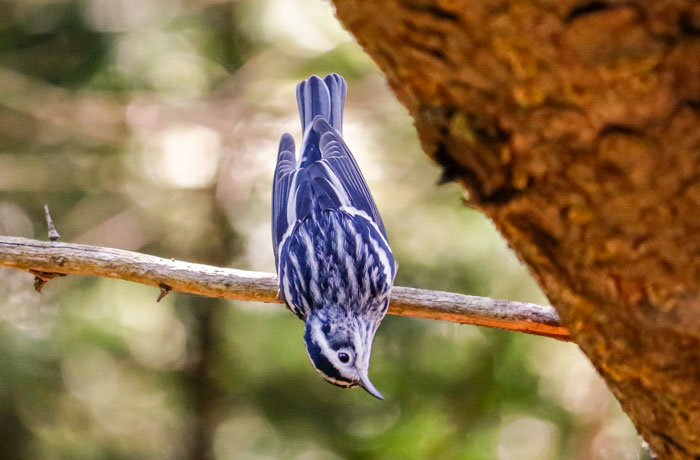
These birds are one of the first migrants to arrive on breeding grounds, the song of the black-and-white warbler is reminiscent of a high-pitched rusty wheel turning and is surely an early sign of spring.
Black-and-white Warbler Size & Shape
Black-and-white warblers are medium-sized birds. They have a fairly long, slightly downcurved bill. Their heads often appear somewhat flat and streamlined, with short necks. They have long wings and short tails.
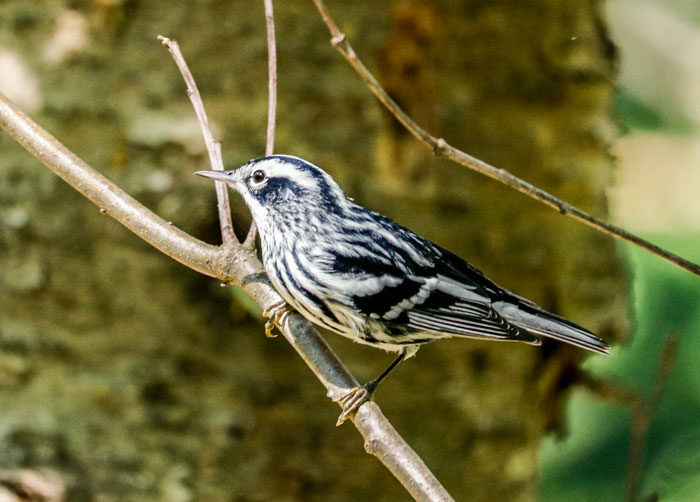
Black-and-white Warbler Color Pattern
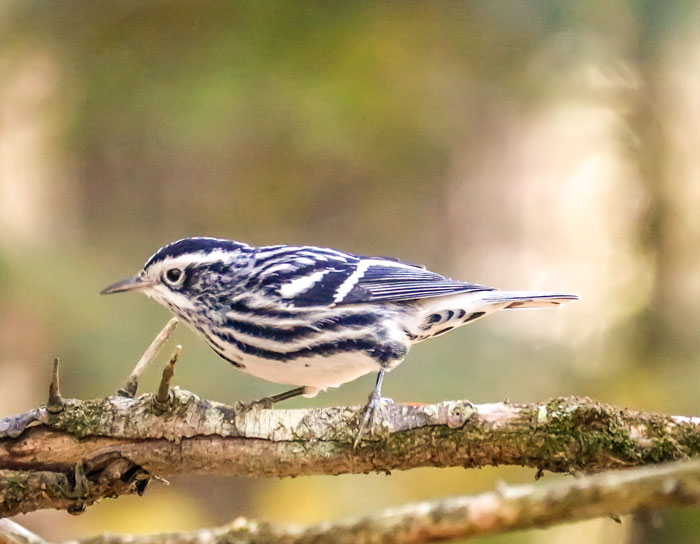
These birds are boldly striped in black and white. Their black wings are highlighted by two wide, white wing bars. Adult males have more obvious black streaking, particularly on the underparts and the cheek.
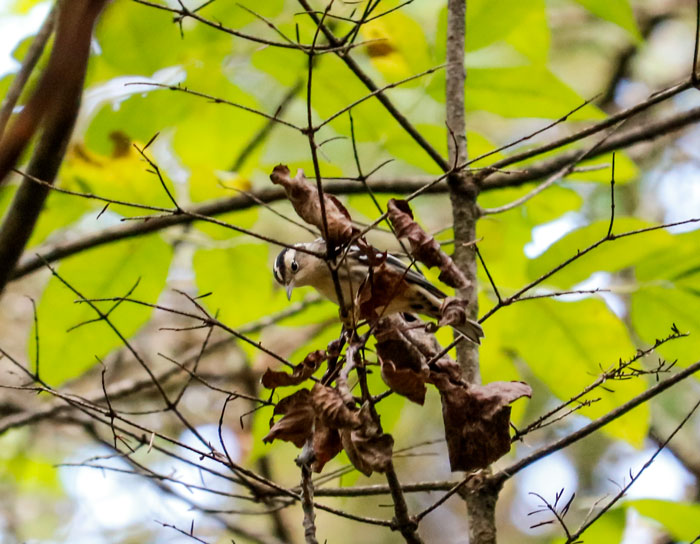
Females, especially immature black-and-white warblers are paler, with less streaking and usually a wash of buff on the flanks. The undertail coverts have distinctive large black spots.

Black-and-white Warbler Habitat
Males are territorial in both their summer and winter habitats. You will typically find these warblers in deciduous forests and mixed forests of deciduous trees and conifers. They can be found in many habitats during their migration, especially woodlots and forests in riparian settings. In their tropical wintering grounds, these birds use a vast range of habitats, including lawns, gardens, and other urban settings, fruit orchards, shade-coffee plantations, wetlands, mangroves, and all types of forests.
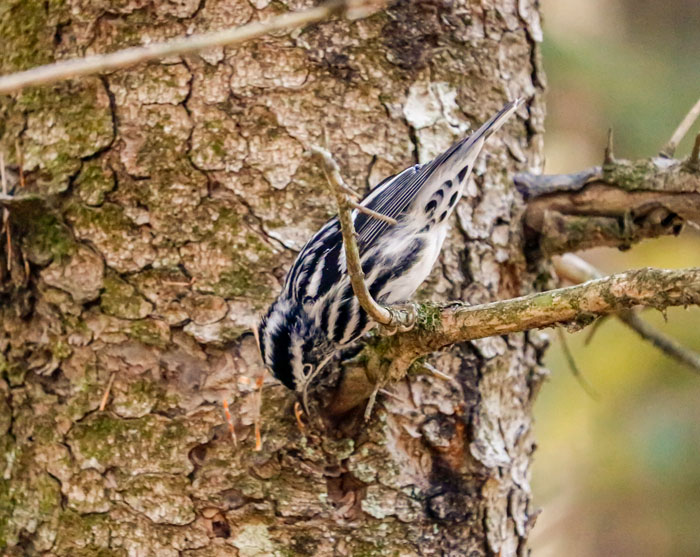
Black-and-white Warbler Behavior
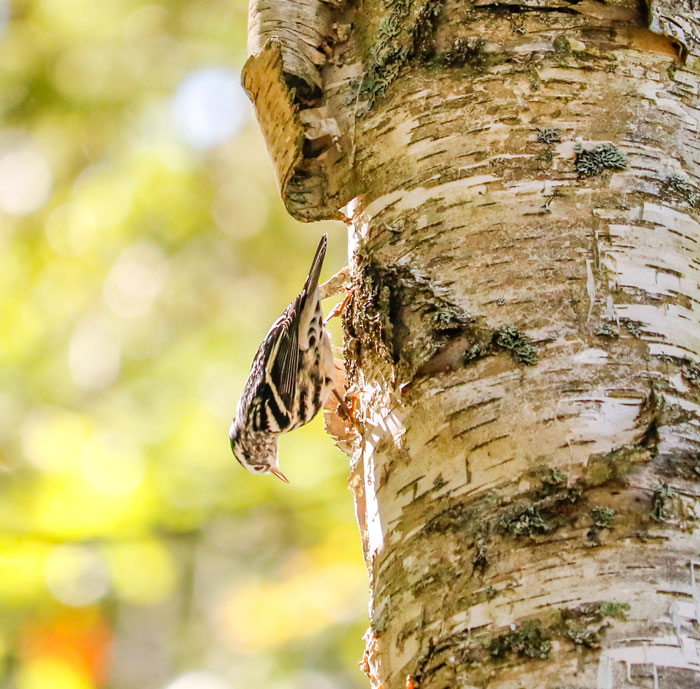
As mentioned above, the behavior of the black-and-white warbler is quite similar to that of the nuthatch, adapted to foraging for hidden insects in the bark of trees by creeping up, down, and around branches and trunks. It switches its body from side to side at each hop while foraging. In early spring, it takes dormant insects from tree trunks and branches. Sometimes flies out after flying insects. Despite their arboreal foraging habits, they interestingly enough, nest on the ground at the bases of trees.
What do Black-and-white Warblers Eat?
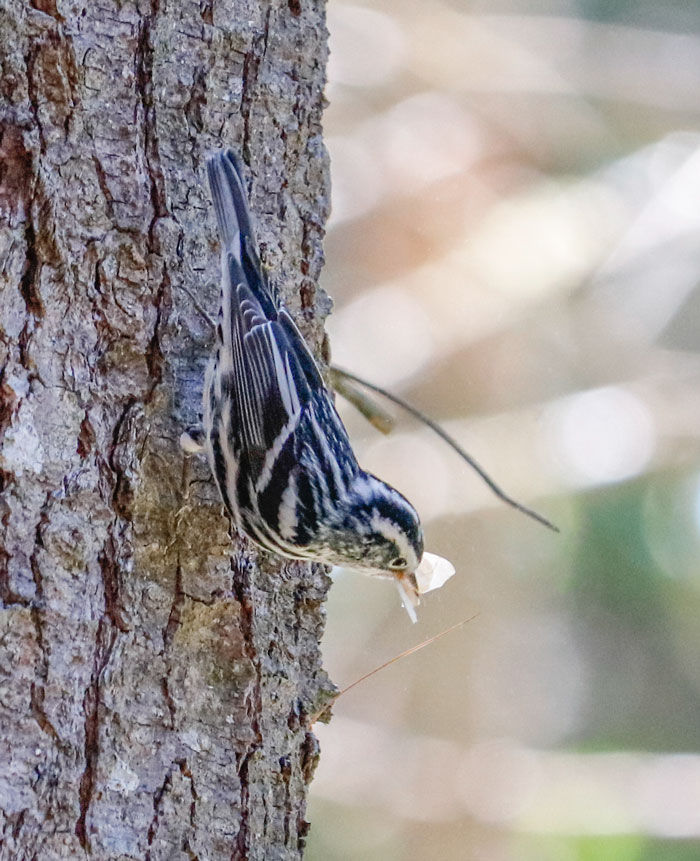
Black-and-white warblers eat mostly insects. Moth and butterfly larvae make up the bulk of their diet during spring migration and throughout the breeding season. Other arthropod prey includes ants, flies, spiders, daddy longlegs, click and leaf beetles, wood-borers, leafhoppers, and weevils. They also like grubs growing in logs and will also take advantage and feed on insects attracted to yellow-bellied sapsucker Sphyrapicus varius sap wells.
Black-and-white Warbler Songs & Calls
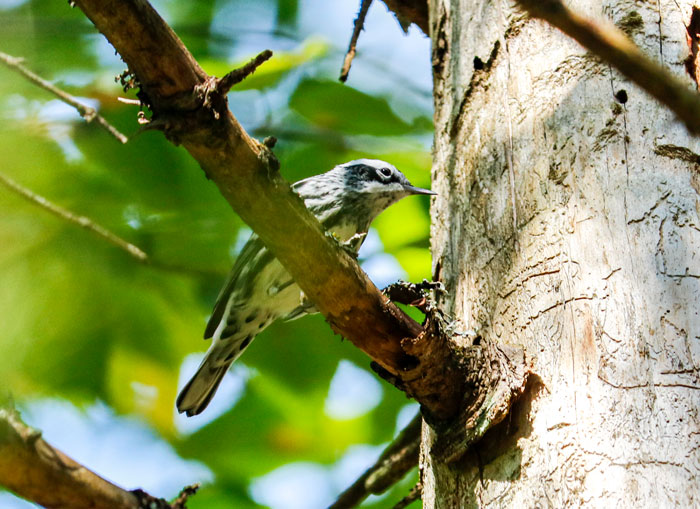
The male black-and-white warbler sings a thin, high-pitched, repetitive weesy, weesy, weesy, weesysong that lasts for about three seconds. On breeding grounds, the song may be longer, faster, and more varied in pitch. Males sing a softer version of the song when they are close to females during courtship and nest building.
Both the male and female black-and-white warblers give a sharp chit or pit call, with many variations. Females will call to mates when away from the nest, and males may call to mates in order to maintain contact.
Black-and-white Warbler Breeding & Nesting
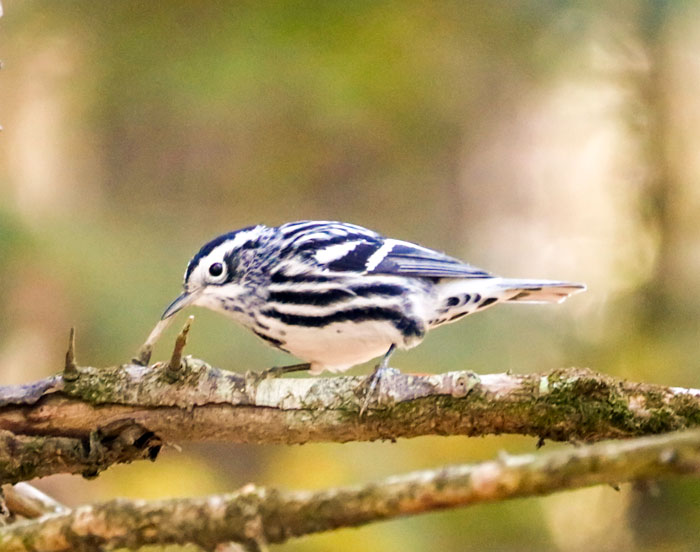
Males arrive on breeding grounds in late April, before the arrival of the females. During courtship, males will chase females, with a great deal of singing and fluttering.
Nests are placed on the ground (or less than two feet up), under dead leaves or limbs, against a shrub, rock, log, or tree. They are usually constructed in a cavity at top of a stump or in a depression in the ground. The construction of the nest included an open cup (built by the female) made of leaves, coarse grass stems, bark strips, pine needles, rootlets; lined with fine grass or fur.
There are five, sometimes, four, rarely six creamy-white colored eggs, flecked with brown at the large end. The eggs are incubated by the female only for ten to twelve days. Unfortunately, nests are commonly parasitized by cowbirds. This can prove to be challenging for the survival of the nestlings.
Young are fed by both parents. Fledglings leave the nest eight to twelve days after hatching before they are able to fly.
Black-and-white Warbler Migration
The black-and-white warbler is a short to a long-distance migrant. Some individuals will winter as far north as Florida and Baja, California. Others may travel as far as northern South America. Being less dependent on flying insects these birds are typically one of the earliest spring arrivals among Neotropical migrants than other warblers.
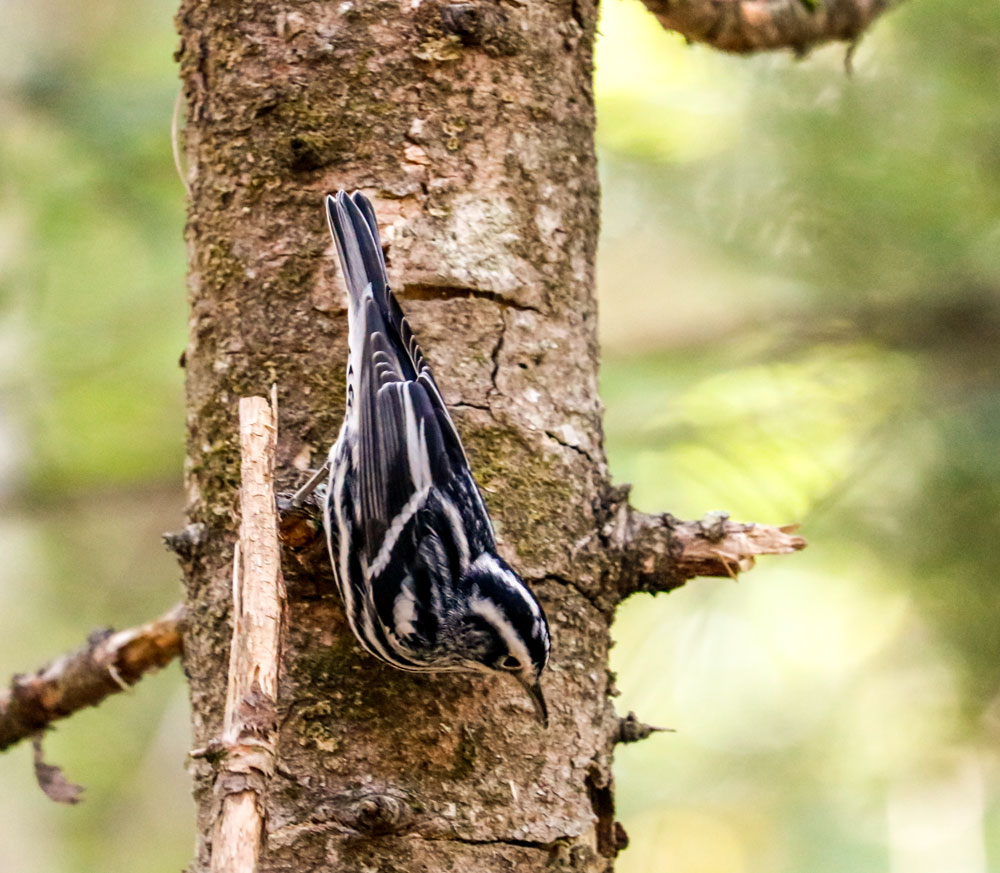
How to Attract Black-and-white Warblers to Your Backyard
Black-and-white warblers aren’t typical visitors to feeders being that they are primarily insectivores. Depending on where you live, you’re not likely to attract warblers with seeds, but warblers love water, especially running water. Warblers are known for enjoying an abundance of water throughout the day. The addition of a birdbath may be enough to attract warblers to your backyard. If you want to increase your chances of attracting these warblers to your backyard, a moving water feature is most likely your best bet.
Another thing to consider is if your yard is void of trees, consider planting a variety of trees such as cypress, oak, and pine, as well as other types of trees to attract these birds. This will be a long-term solution, but it’s worth it if you want to enjoy these warblers in your yard. Also, avoid the removal of poison ivy or poison oak because warblers enjoy them very much.
Thank you for reading and I hope enjoyed learning a bit about these warblers.
Resources used for this post:
allaboutbirds.org & audubon.org
Leave a Reply